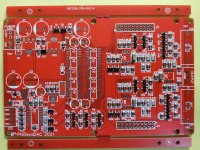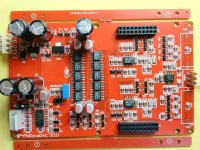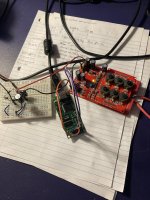Based on my own very brief listen to the Khadas Tone Board 2 (upgraded over the original Tone Board) I'd not describe that as 'transparent' or 'accurate' from a subjective point of view. Sure its measurements are very good but sound-wise I found it adding extra noise to higher frequencies. This is a little bit like the flavour of the 3rd order filter in Deca DAC but the latter has better ambience retrieval in my estimation.
As to your 'comparison video' what do you mean? Try to demonstrate the differences in a video? I doubt that would work as it would depend on the DAC that played the video back. Yes the filters can be swapped in and out, even with power on. But if you leave the amp on there's a mighty 'thunk' through the speakers when they're removed and replaced.
As for questions in relation to Volumio I haven't ever used it, but I think only DACs with auxiliary functions need to be recognized by the software. Deca DAC has no such functions.
As to your 'comparison video' what do you mean? Try to demonstrate the differences in a video? I doubt that would work as it would depend on the DAC that played the video back. Yes the filters can be swapped in and out, even with power on. But if you leave the amp on there's a mighty 'thunk' through the speakers when they're removed and replaced.
As for questions in relation to Volumio I haven't ever used it, but I think only DACs with auxiliary functions need to be recognized by the software. Deca DAC has no such functions.
Describing the sound with words is very complex and at the same time very subjective, since it depends on each person's hearing, experience, and listening conditions. I'm just trying to understand what Phideca dac sounds like. One of the aspects of this hobby is that you learn continuously. Once again thank you for your attention. Greetings!
Thank you for your response. I have a amplifier Yamaha A1, Speakers Quadral Montan Mk3. Do you think it is a quality set?
Hi! Maybe somebody know this. Does volumio or Moodeaudio recognise the Phidac hex or the Phideca dac?
Thanks in advance!
Hi Cuchu,
I have used Volumio and Moode with five different TDA1387 DACs using I2S connection. With both software players, you can use either "Generic" or "RPI-DAC" drivers. Try all the options and see what you like best! They do sound different IME.
Describing the sound with words is very complex and at the same time very subjective, since it depends on each person's hearing, experience, and listening conditions. I'm just trying to understand what Phideca dac sounds like.
I agree that describing how something sounds is totally subjective. Especially in this case where the aim of the design is to have a device which contributes as little of its own sound as possible. I know that pretty much all DAC designers say that and aim for that, but many (by no means all) of them use numbers as a demonstration that they've achieved that. I'm not of the view that numbers in and of themselves show that a DAC is subjectively transparent. So then, how to tell?
For me the way to tell is through listening to a wide range of recordings through the DAC over many hours and noticing how much of their own individual character is apparent. With a subjectively more transparent DAC a recording is going to sound more like itself and hence recordings sound more individual. When a DAC imparts its own character then that character is noticeable on all recordings, rendering them less individual, less unique less 'apart' from other recordings.
Some more details on the Deca DAC kit
Here are a couple of shots taken with my phone to show what the finished baseboard DAC and the pre-soldered board that comes with the kit look like. By mentally subtracting one from the other you'll be able to figure out which components you have to solder. I'll have a graphic along in a day or so for kit builders to refer to.
The output caps aren't shown fitted on the finished baseboard - they are 4.7uF Wimas and these suit driving a typical input impedance preamp (22k or more input Z). There's a provision to use off-board caps if you prefer - solder the 0R 0805 resistors which short out the on-board caps. I normally use off-board caps myself as I'm driving my trafo-input TDA8932 amp boards and they need an electrolytic of 1000uF or so to keep the output impedance low enough at LF.
Here are a couple of shots taken with my phone to show what the finished baseboard DAC and the pre-soldered board that comes with the kit look like. By mentally subtracting one from the other you'll be able to figure out which components you have to solder. I'll have a graphic along in a day or so for kit builders to refer to.
The output caps aren't shown fitted on the finished baseboard - they are 4.7uF Wimas and these suit driving a typical input impedance preamp (22k or more input Z). There's a provision to use off-board caps if you prefer - solder the 0R 0805 resistors which short out the on-board caps. I normally use off-board caps myself as I'm driving my trafo-input TDA8932 amp boards and they need an electrolytic of 1000uF or so to keep the output impedance low enough at LF.
Attachments
Last edited:
Kits are available now, the queue of people who assembled before the official opening has been addressed. As far as I recall @cuchu you are going to get back to me to firm up your requirements?
Hello @abraxalito! At the moment I have an unfinished project. While I finish it, I will continue researching and preparing myself to be able to carry out a project like your dac. As soon as I am ready, I will contact you again. Greetings and thanks!
Phidac sound reminds me of a Denafrips dac sound. After the pandemic is over, l will arrange a direct comparison
Hi kp93300! Have you try both dacs? How do you compare their sound?
Regards!
Another happy customer here! Shipping only took 3 days to Seattle which is amazing. It took me about 5 hours to solder everything up. I just followed the guide and it helped me find that I didn't get one of the ICs soldered fully.
First impressions-
It sounds awesome! The noise floor is so much lower than my old schiit modi and this pcm2704 dac I have. The bass really stands out as coming alive.
I will have to experiment with power supplies and different usb interfaces, but so far I'm very impressed with the Phi DecaDAC
First impressions-
It sounds awesome! The noise floor is so much lower than my old schiit modi and this pcm2704 dac I have. The bass really stands out as coming alive.
I will have to experiment with power supplies and different usb interfaces, but so far I'm very impressed with the Phi DecaDAC
Attachments
Last edited:
That's really good news Nick - thanks very much for sharing. You're the first listener to Deca DAC anywhere outside of my apartment that I am aware of 🙂
I just ordered my Phideca dac kit. Looking forward to arriving soon and getting down to work! Thanks Richard!
I hope to hear your comments soon, Cuchu
(I can't resist posting and seeing two spanish flags together, we are so few here 😀)
(I can't resist posting and seeing two spanish flags together, we are so few here 😀)
Last edited:
Today I got my Phidecca dac (7th order filter) running so I thought I'd give my impressions of it compared to the Phihex it replaced and a very nice AK4493 dac that I have. My implementation uses a Jlsounds usb to I2S card with an independent psu (Studer 9000) and the Phidecca uses a Salas UBIB psu. I did a direct swap out of the Phihex for the Phidecca. The AK4493 also uses a Jlsounds usb board with 2 independent Salas UBIB psus for the usb board and the Ak4493 dac and a dual rail UBIB for the output stage. The output stage has been upgraded with Sparkos labs discrete opamps (nice upgrade).
The Phihex sounds very nice, good tonality and soundstage, unfatiguing. It sounded a little bit softer than the AK4493, the AK4493 seemed to have a blacker background and sounded a bit more dynamic, but the differences between the two were small. The Phihex did sound more natural. In a head to head comparison I might be tempted to give the nod to the AK4493, but I found myself listening to the Phidecca more and more.
Swapping the Phidecca into the system made an immediate improvement over the Phihex. Better everything, great sense of space, better decay, better dynamics, more detail, better soundstage/imaging, in general it just sounds more real. The AK4493 sounds hard and fatiquing in comparison, and cannot match the Phidecca for it's sense of reality or space. The Phidecca is clearly a better sounding dac than the AK4493 and has bumped it down to backup duty.
My congratulations to Richard for a wonderful design.
The Phihex sounds very nice, good tonality and soundstage, unfatiguing. It sounded a little bit softer than the AK4493, the AK4493 seemed to have a blacker background and sounded a bit more dynamic, but the differences between the two were small. The Phihex did sound more natural. In a head to head comparison I might be tempted to give the nod to the AK4493, but I found myself listening to the Phidecca more and more.
Swapping the Phidecca into the system made an immediate improvement over the Phihex. Better everything, great sense of space, better decay, better dynamics, more detail, better soundstage/imaging, in general it just sounds more real. The AK4493 sounds hard and fatiquing in comparison, and cannot match the Phidecca for it's sense of reality or space. The Phidecca is clearly a better sounding dac than the AK4493 and has bumped it down to backup duty.
My congratulations to Richard for a wonderful design.
- Home
- Vendor's Bazaar
- PhiDAC hex kits with pre-built filters



